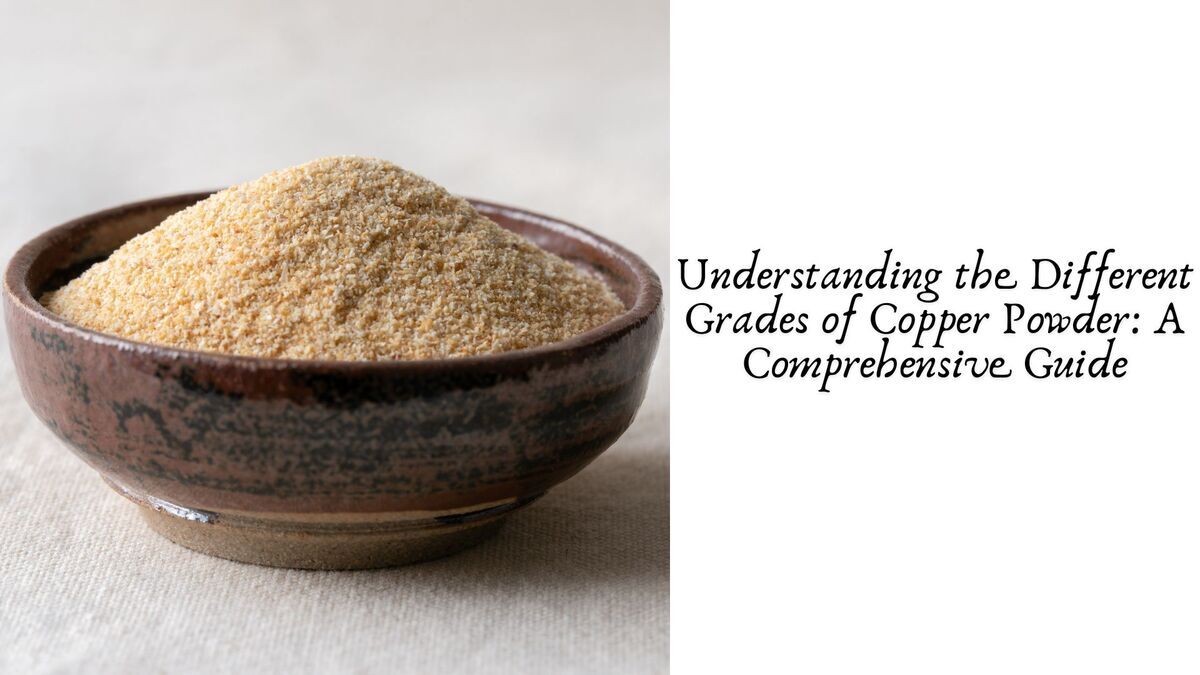
Understanding the Different Grades of Copper Powder
- Book My Author
- Business
- 2025-09-18 20:40:44
- 759K
Copper powder plays a pivotal role in a wide array of industries, from electronics and metallurgy to additive manufacturing and chemical processes. However, not all copper powders are created equal. They are available in different grades, each tailored to specific applications and performance requirements. Understanding these grades is essential for manufacturers, engineers, researchers, and even hobbyists to ensure optimal performance and cost-efficiency.
This article provides a detailed exploration of the different grades of copper powder, their classification criteria, properties, and common uses.
What Is Copper Powder?
Copper powder is a fine, granular form of elemental copper produced through various processes such as atomization, electrolysis, or reduction of copper oxides. Its high conductivity, malleability, and resistance to corrosion make it a valuable material for industrial and commercial use.
Key Factors in Grading Copper Powder
Grading copper powder involves evaluating its physical, chemical, and structural properties. Below are the main criteria used:
Purity
Purity is a fundamental aspect of copper powder grading. High-purity copper powders (typically above 99.9%) are preferred for electrical and electronic applications, whereas lower-purity grades may be acceptable for less critical uses.
- High Purity: ≥ 99.9%
- Standard Purity: 99.5–99.8%
- Commercial Grade: < 99.5%
Particle Size and Distribution
Copper powders come in a range of particle sizes, generally expressed in microns or mesh sizes. The particle size affects flowability, compaction, and sintering behavior.
- Fine Grade: < 10 µm – Ideal for coatings and catalysts
- Medium Grade: 10–50 µm – Common in powder metallurgy
- Coarse Grade: > 50 µm – Used in structural applications
Particle Shape
Particle morphology influences the surface area and packing density of the powder. The shape depends on the manufacturing process:
- Spherical: Often produced via gas atomization, suitable for additive manufacturing
- Irregular/Dendritic: Produced via electrolysis, ideal for sintering applications
- Flaky: Used in conductive pastes and paints
Apparent and Tap Density
These densities indicate how tightly the powder can pack, which is vital for determining suitability in mold filling and sintering.
Flow Rate
Flowability affects how easily the powder can be processed in automated systems. Better flow rate is generally associated with spherical particles and uniform size distribution.
Major Grades of Copper Powder and Their Applications
Electrolytic Copper Powder
- Grade Characteristics: High purity (≥ 99.9%), dendritic particles, excellent compressibility.
- Applications: Electrical contacts, friction materials, sintered parts, chemical catalysts.
Atomized Copper Powder
- Grade Characteristics: Spherical particles, good flowability, moderate to high purity.
- Applications: 3D printing (metal additive manufacturing), brazing, powder metallurgy.
Reduced Copper Powder
- Grade Characteristics: Made by hydrogen reduction of copper oxide, irregular shapes, variable purity.
- Applications: Metal-ceramic bonding, magnet materials, alloy preparation.
Pre-Alloyed Copper Powder
- Grade Characteristics: Copper alloyed with other metals like tin, nickel, or iron.
- Applications: Bearings, filters, structural parts in powder metallurgy.
Coated Copper Powder
- Grade Characteristics: Copper particles coated with materials like silver or graphite.
- Applications: Electrical contacts, high-lubricity applications, corrosion-resistant parts.
Industry Standards and Classifications
Various organizations provide standards for copper powder grades to ensure quality and consistency:
- ASTM B170: Covers electrolytic copper powder.
- ASTM B216: Specifies atomized copper powders.
- ISO 4491: Deals with measurement of particle size, apparent density, and flow rate.
Manufacturers often provide a technical datasheet outlining the specific grade properties, including:
- Purity level
- Particle size range
- Morphology
- Bulk and tap densities
- Flow rate (Hall flow test results)
- Moisture content
Emerging Trends in Copper Powder Grades
With the rise of advanced manufacturing and nanotechnology, copper powders are evolving in both grade complexity and specialization. Innovations include:
- Nano-sized copper powders for antimicrobial coatings and electronics.
- Customized pre-alloyed grades for aerospace and automotive industries.
- Sustainable production methods focusing on low-energy and low-waste synthesis.
Conclusion
The grade of copper powder you choose can significantly impact the quality, efficiency, and performance of your end product. By understanding the classification systems and performance characteristics, manufacturers and users can make informed decisions tailored to their application needs.
As industries continue to demand precision materials, the role of correctly graded copper powders will only become more crucial. Whether you're fabricating electronic components, developing new alloys, or pushing the boundaries of 3D printing, selecting the right copper powder grade is key to success.










